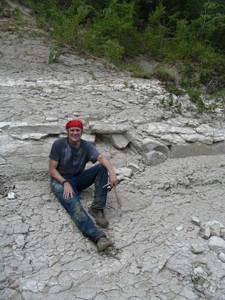
What Makes a Fossil?
Weve long been concerned with the quality of the fossil record, says Arnie Miller. The key to all this of course is the available fossil record. Miller points out that the most prominent issue is that the record gets larger and easier to sample the closer one gets to the present day in the Cenozoic Era. Therefore, weve long been concerned that global diversity curves, which show a big increase toward the present day, are biased.
The rock is less hard, Miller notes. For example, on the Virginia Coast in sediments that are only a few tens of millions of years old, you dont need a hammer, you need a sieve. Around Cincinnati, where the rocks preserve exquisite fossils that are more than 450 million years old, jackhammers and backhoes are sometimes helpful.
Miller also emphasizes the subtle difference between samples taken around the world versus literature published from around the world. That is, not every sample taken is subsequently described in the literature. So in examining fossils and analyzing them, there are several inherent challenges, some natural and some under human control:
Environmental
How preserved
Ecological
Nature of the rock itself
Duration of sampling
Number of samples
Number of articles published
The nature of communities changes over time how do you tally and correct for that? says Miller. And were trying to correct for all of them, basically.
Therefore, we have asked, Can we quantitatively correct for the differences in sampling from interval to interval? Miller says. Operationally, this involves some fairly arcane quantitative methods that, at heart, have a very simple goal: to quantitatively equalize the size of the paleontological sample from interval to interval throughout the geological record, so that we can build a new diversity curve that is free of the distortion that changes in sampling inevitably impart.
Related Stories
2024 Daniel Drake Medals to be awarded April 27
April 24, 2024
The UC College of Medicine will award three people with 2024 Daniel Drake Medals April 27.
UC education allowed couple to make mark on Cincinnati
April 24, 2024
As a native of Defiance, Ohio, John Deatrick, CEAS ’79, says arriving in Cincinnati to attend the University of Cincinnati in 1963 felt like landing in New York City.
Engineering student studying flight physics of birds
April 24, 2024
After earning a bachelor's degree in mechanical engineering in Nepal, Sameer Pokhrel came to the United States to further his education. From an early age, he had a lifelong fascination with aviation. As an adult, he transformed this fascination into a career, pursuing a doctoral degree in aerospace engineering at the University of Cincinnati's historic program. Here, he has succeeded in research, instruction, and was recently named Graduate Student Engineer of the Month by the College of Engineering and Applied Science.
